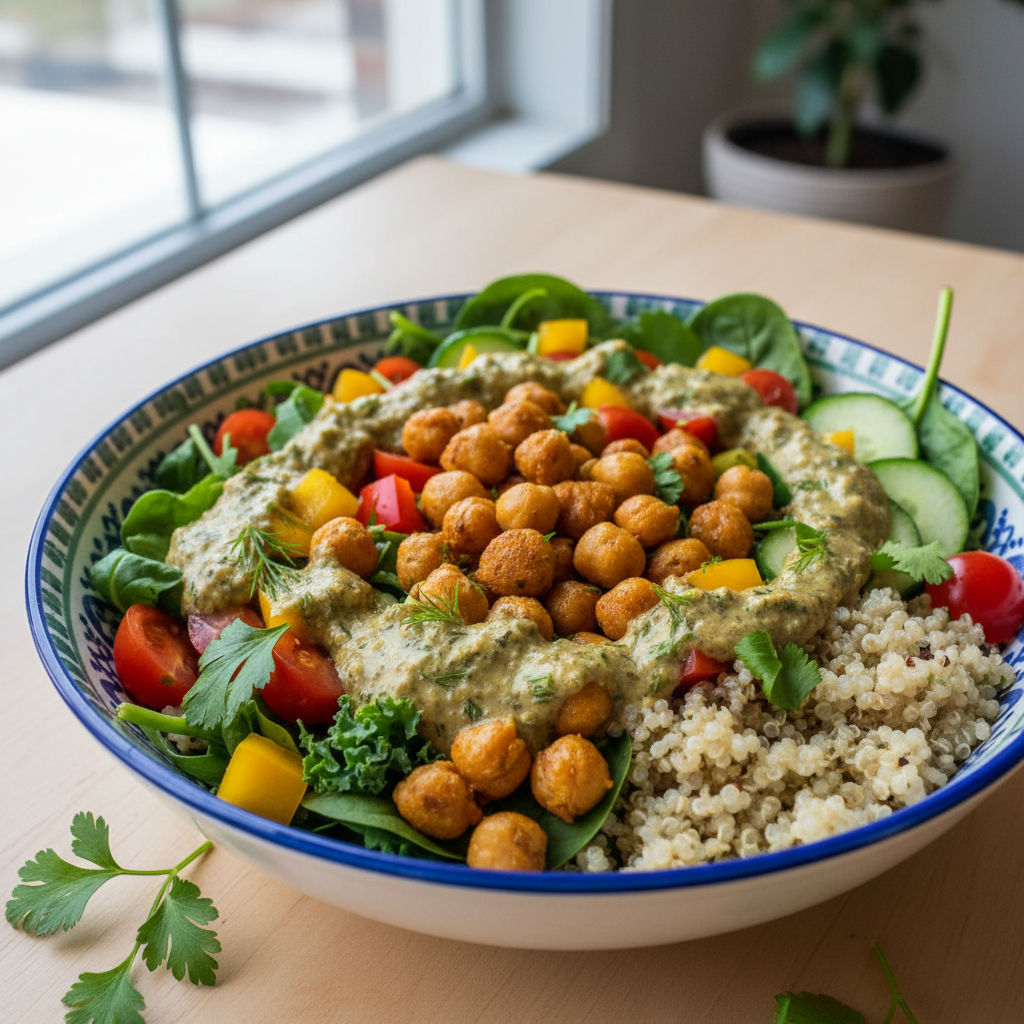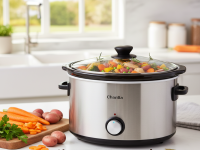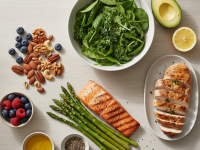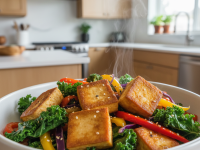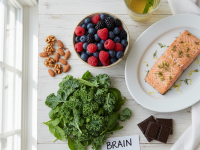Hey there, health-conscious foodies! Are you tired of feeling like healthy eating means sacrificing flavor, especially when you’re trying to cut down on sodium? I totally get it. For years, I struggled with finding meals that were both genuinely good for me and genuinely exciting to eat. Every “low-sodium” recipe I found seemed to scream “bland!” and frankly, that’s just not how I wanted to live my culinary life. But then, I discovered the magic of the power bowl – specifically, this incredibly satisfying Low-Sodium Chickpea & Quinoa Power Bowl.
This isn’t just another recipe; it’s a game-changer. It’s packed with flavor, vibrant colors, and all the nutrients you need to feel energized without any of that hidden sodium sneaking in. Whether you’re actively managing your blood pressure, looking to reduce bloating, or simply aiming for a cleaner, more plant-forward diet, this bowl is about to become your new best friend. It’s incredibly versatile, easy to prepare, and most importantly, it tastes absolutely fantastic. Trust me, your taste buds (and your body) are going to thank you!
Why Go Low-Sodium? My Personal Journey & The Benefits
My journey to low-sodium cooking wasn’t just a whim; it was a necessity. A few years ago, I started noticing I felt sluggish, a bit bloated, and just generally not at my best. After a check-up, my doctor suggested I pay more attention to my sodium intake. It was a wake-up call. I thought I was eating relatively healthy, but once I started reading labels, I was genuinely shocked by how much sodium was lurking in seemingly iocent foods, even “healthy” ones!
The immediate thought was, “Oh no, everything’s going to taste like cardboard now!” But I was determined to prove myself wrong. I learned that reducing sodium isn’t just about avoiding the salt shaker; it’s about embracing a whole new world of flavors. The health benefits are immense:
- Heart Health: Lowering sodium can significantly help manage blood pressure, reducing the risk of heart disease and stroke.
- Kidney Function: It helps lighten the load on your kidneys, which are responsible for filtering waste.
- Reduced Bloating: Excess sodium causes your body to retain water, leading to that uncomfortable puffy feeling. Cutting back can make a noticeable difference.
- Improved Taste Buds: Honestly, after a while, you’ll find that your palate becomes more sensitive to natural flavors. Foods you once thought were bland will come alive!
This power bowl became one of my go-to recipes precisely because it shatters the myth that low-sodium means low-flavor. It’s proof that you can eat incredibly well and support your health at the same time.
The Superstars of Our Bowl: Chickpeas & Quinoa
Every great power bowl needs a solid foundation, and for this recipe, we’re relying on two nutritional powerhouses: chickpeas and quinoa. These aren’t just trendy ingredients; they’re genuinely fantastic for you and work together beautifully to create a satisfying and complete meal.
Chickpeas: The Versatile Legume
Ah, chickpeas! Also known as garbanzo beans, these little legumes are incredibly versatile and a staple in many cuisines around the world. Here’s why they’re perfect for our bowl:
- Protein Powerhouse: They’re an excellent source of plant-based protein, helping you feel full and satisfied.
- Fiber Rich: Packed with dietary fiber, which aids digestion and helps regulate blood sugar levels.
- Nutrient Dense: They offer a good dose of folate, iron, magnesium, and zinc.
- Texture & Flavor: When roasted or lightly sautéed, they get a lovely slightly crispy exterior and a creamy interior, soaking up all the amazing flavors you add.
Quinoa: The Ancient Grain Wonder
Quinoa might look like a grain, but it’s actually a seed, often referred to as a “pseudo-cereal.” It’s been a staple food for thousands of years, and for good reason!
- Complete Protein: This is huge! Unlike most plant foods, quinoa contains all nine essential amino acids, making it a complete protein source – fantastic for vegetarians and vegans.
- Fiber-Packed: Just like chickpeas, quinoa is high in fiber, contributing to digestive health and satiety.
- Rich in Minerals: It’s loaded with magnesium, B vitamins, iron, potassium, calcium, phosphorus, and vitamin E.
- Gluten-Free: A great option for those with gluten sensitivities.
- Easy to Cook: It cooks up quickly, making it ideal for busy weeknights.
Together, chickpeas and quinoa create a dynamic duo that forms the hearty, nutritious backbone of our power bowl, ensuring you stay full, energized, and nourished.
Crafting Your Flavorful Low-Sodium Chickpea & Quinoa Power Bowl
Alright, let’s get to the good stuff – making this incredibly delicious and healthy power bowl! This recipe is designed to be bursting with flavor without relying on excess salt.
Ingredients You’ll Need:
- 1 cup uncooked quinoa, rinsed thoroughly
- 2 cups low-sodium vegetable broth or water
- 1 (15-ounce) can chickpeas, rinsed and drained well
- 1 tablespoon olive oil
- 1 teaspoon smoked paprika
- ½ teaspoon garlic powder
- ½ teaspoon onion powder
- ¼ teaspoon black pepper
- 2 cups mixed greens (spinach, kale, spring mix)
- ½ cucumber, diced
- 1 bell pepper (any color), diced
- ½ cup cherry tomatoes, halved
- ¼ cup fresh parsley or cilantro, chopped
- For the Low-Sodium Lemon-Herb Dressing:
- 3 tablespoons olive oil
- 2 tablespoons fresh lemon juice
- 1 tablespoon apple cider vinegar (optional, for extra tang)
- 1 clove garlic, minced
- 1 teaspoon dried oregano or mixed Italian herbs
- ¼ teaspoon black pepper
- Pinch of red pepper flakes (optional, for a little kick)
Equipment:
- Medium saucepan with lid
- Large skillet or baking sheet
- Large mixing bowl
- Small bowl or jar for dressing
Step-by-Step Instructions:
- Cook the Quinoa: In a medium saucepan, combine the rinsed quinoa and low-sodium vegetable broth (or water). Bring to a boil, then reduce heat to low, cover, and simmer for 15 minutes, or until all liquid is absorbed and the quinoa is fluffy. Remove from heat and let it sit, covered, for another 5 minutes before fluffing with a fork.
- Prepare the Flavorful Chickpeas: While the quinoa cooks, heat 1 tablespoon of olive oil in a large skillet over medium heat. Add the rinsed and drained chickpeas. Sprinkle with smoked paprika, garlic powder, onion powder, and black pepper. Sauté for 8-10 minutes, stirring occasionally, until they’re slightly crispy and fragrant. Alternatively, you can roast them on a baking sheet at 400°F (200°C) for 20-25 minutes.
- Whip Up the Dressing: In a small bowl or jar, whisk together all the dressing ingredients: 3 tablespoons olive oil, fresh lemon juice, apple cider vinegar (if using), minced garlic, dried oregano, black pepper, and red pepper flakes (if desired). Taste and adjust seasonings as needed – remember, we’re relying on herbs and acidity, not salt, for flavor!
- Chop the Veggies: While everything else is cooking, chop your cucumber, bell pepper, and halve your cherry tomatoes.
- Assemble Your Power Bowl: This is the fun part! In a large bowl, start with a base of mixed greens. Add a generous portion of the cooked quinoa. Then, pile on the crispy chickpeas and all your fresh, chopped vegetables.
- Drizzle and Serve: Drizzle a good amount of your homemade lemon-herb dressing over the top. Garnish with fresh parsley or cilantro. Toss gently to combine all the delicious flavors and textures, then dig in!
Customization is Key: Make It YOUR Power Bowl!
One of the things I love most about power bowls is how adaptable they are. This recipe is a fantastic starting point, but feel free to let your creativity (and whatever’s in your fridge) guide you. I’ve tried so many variations, and they’ve all been delicious:
- Vary Your Veggies: Don’t limit yourself to cucumber and bell pepper! Add roasted sweet potatoes, steamed broccoli, shredded carrots, thinly sliced red onion, or even some sautéed mushrooms.
- Boost Healthy Fats: A few slices of ripe avocado or a sprinkle of toasted pumpkin seeds or sunflower seeds can add a wonderful creamy texture and healthy fats.
- Add More Protein: If you want an extra protein punch, consider adding a hard-boiled egg, some grilled tofu, or even some low-sodium grilled chicken (if you’re not strictly vegetarian).
- Spice It Up: A dash of cayee pepper to your chickpeas, a pinch of cumin, or a sprinkle of everything bagel seasoning can totally change the flavor profile.
- Different Dressings: While this lemon-herb dressing is a wier, feel free to experiment with a low-sodium tahini dressing, a simple vinaigrette with balsamic vinegar, or a sugar-free, low-sodium peanut sauce.
This bowl has truly become a staple in my meal prep routine. I often cook a big batch of quinoa and chickpeas at the begiing of the week, chop all my veggies, and then just assemble my bowls fresh each day. It makes healthy, low-sodium eating so much easier and more enjoyable!
My Top Tips for Mastering Low-Sodium Cooking
Navigating the world of low-sodium eating can feel daunting at first, but with a few tricks up your sleeve, it becomes second nature. Here are some of the tips I’ve picked up on my journey that have made a huge difference:
- Embrace Herbs and Spices: These are your new best friends! Garlic, onion powder, smoked paprika, cumin, oregano, thyme, rosemary, chili powder – the possibilities are endless. Don’t be shy; layer them to build complex flavors.
- Acids are Flavor Boosters: Lemon juice, lime juice, and various vinegars (apple cider, balsamic, red wine) are fantastic for brightening flavors and mimicking some of the “pop” that salt provides.
- Cook from Scratch: This is the biggest one. When you cook at home, you have complete control over what goes into your food. Processed foods are notorious for hidden sodium.
- Read Labels Diligently: Even “healthy” caed goods or sauces can be loaded with sodium. Always opt for “low-sodium,” “no-salt-added,” or “reduced-sodium” versions. Rinse caed beans thoroughly!
- Use Fresh Ingredients: Naturally, fresh fruits, vegetables, and lean proteins are lower in sodium than their processed counterparts.
- Taste, Taste, Taste: Season as you go and taste frequently. You’ll learn what works and what doesn’t, and you’ll become more intuitive with flavor balancing.
Ready to Power Up Your Plate?
I truly hope this Low-Sodium Chickpea & Quinoa Power Bowl recipe inspires you to take charge of your health and discover just how incredibly delicious low-sodium eating can be. It’s more than just a meal; it’s a testament to how vibrant and flavorful food can be when you focus on wholesome ingredients and creative seasoning. I’ve found so much joy and better health through recipes like this, and I’m confident you will too.
So, why not give it a try this week? Whip up a batch, experiment with your favorite veggies, and tell me what you think. Your body (and your taste buds!) will thank you for this nourishing, delightful meal. Happy cooking!
